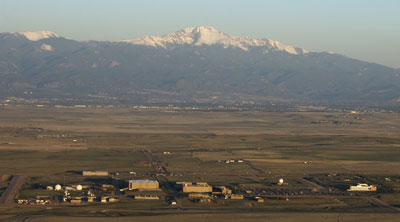Spacepower and location, location, locationby Taylor Dinerman
|
| Colorado Springs is a beautiful place, but it is isolated from the complexities of Washington. |
Many of the problems with current and future military space systems, notably the Space Based Infra Red System (SBIRS) or Space Based Radar, might have been avoided if someone of four-star rank was in Washington riding herd on the requirements and technology development processes. Perhaps someone of that rank is not really needed to keep the program managers from being overwhelmed by the sorts of extraneous demands that hurt SBIRS, such as those that came from the US Forest Service, who wanted to use the satellites to keep track of wildfires. Sometimes, however, only a very senior officer has the clout to say no to another four star or to a very high-ranking civilian.
In World War Two, Hap Arnold made all the major aviation procurement decisions himself and he was not afraid to take responsibility. When the B-29 program was in deep trouble Arnold didn’t try and pass the buck or hide behind the bureaucracy, he put his career on the line and set out to fix the problems. The Air Force should take a good hard look at what is preventing the emergence of the next generation of Hap Arnold’s.
One factor is isolation: senior officers are far more isolated from their peers and their civilian superiors today than ever before. When George Marshall was the Army’s Chief of Staff in World War Two, his office was next door to that of Secretary of War Henry Stimson and, symbolically, the door was always open. Today, the while the Chairman of the Joint Chiefs and the Secretary of Defense may be personally close, they both have huge personal operational and planning staffs that must be managed full-time. Their time is unbelievably precious and they have little, if any, time to consider long-term strategy.
Space, more than any other aspect of modern warfare, requires planning on decadal or ever longer timescales. When the commander of AFSPC is out in Colorado, having only occasional human contact with the Air Force Chief of Staff and with his (or sometime soon perhaps, her) superiors, decisions become based on staff studies and bureaucratic process. What is often needed is intense and very private face-to-face communications that allows all of the complex human, technological, and political factors to be taken into account.
The role of the commander of AFSPC should not be just to train and equip America’s space forces, or to supervise the operations of the satellite controllers. It is to integrate present and, above all, future spacepower into America’s overall strategic and grand strategic goals. The operational and tactical uses of space power are properly the business of lower-ranking space professionals and of the warfighting organizations such as Strategic Command and Central Command.
| Just as no one really doubted the potential of air power in the 1920s, it takes a serious effort to avoid recognizing the potential of space power in the 21st century. Sadly, just like in the 1920s, few military leaders are willing to sacrifice anything in order to develop US space power. |
Last month Air Force magazine did everyone in the space business a big favor by reprinting exerpts from Bernard Schriever’s February 1957 speech on “Space Superiority”. His foresight, nine months before Sputnik was launched, is amazing. More importantly, he said, “We are somewhat in the same position today as were military planners at the close of the First World War, when they were trying to anticipate the use of aircraft in the Second World War.” Half a century later, US military planners are hardly any better off than they were in 1957.
Just as no one really doubted the potential of air power in the 1920s, it takes a serious effort to avoid recognizing the potential of space power in the 21st century. Sadly, just like in the 1920s, few military leaders are willing to sacrifice anything in order to develop US space power. In the 1920s no one wanted to give up the Cavalry or the Coast Artillery in order to fund the Army Air Corps. Today it is hard to know for sure what should be cut from the Defense Department’s budget in order to support space. That decision is a strategic one that can only be made by the Secretary of Defense and, ultimately, the President.
The commander of AFSPC is in a unique position to shape the debate, but he cannot do it from Colorado. Moving the commander and a small staff to the Washington DC area would help to insure that someone with enough clout and enough experience is at the table when decisions on the future of US military space power are made.
